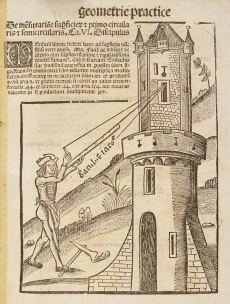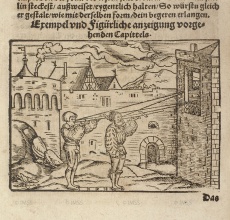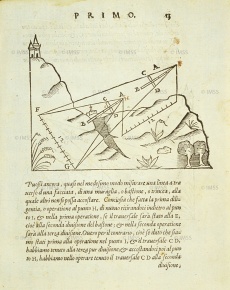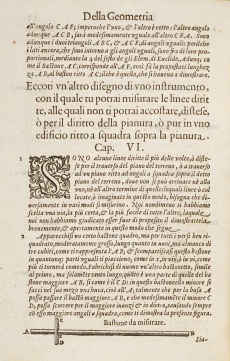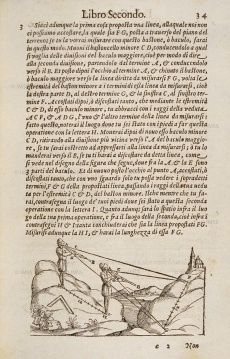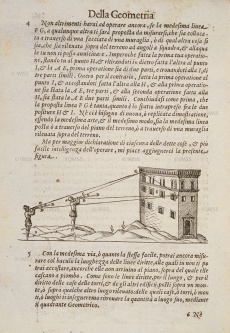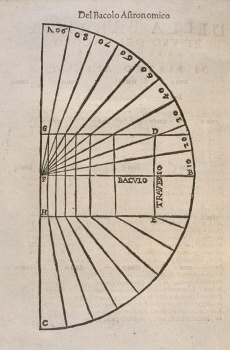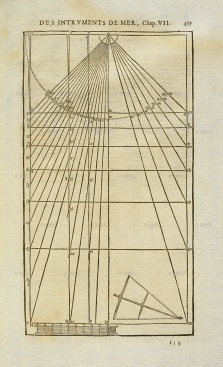Cross-Staff
From Inventions
| (7 intermediate revisions not shown) | |||
| Line 5: | Line 5: | ||
|descrizione= | |descrizione= | ||
| - | Instrument for astronomical and terrestrial measurements invented, or perhaps only described for the first time, by Levi ben Gerson (1342) who traces its origin to the staff of the Patriarch of Israel. It is composed of a stick 6 spans long (approx. 135 cm) and 1 finger wide (approx. 2 cm). Each span is divided into 8 parts, including the first, shorter by 1/20 (approx. 1 cm) which, according to Levi, is the distance between the surface of the eye and the centre of vision. Sliding along the stick is a cross-rod 1 span long. This rod and the section of the stick lying between it and the observer’s eye represent respectively the base and the height of a triangle similar to the one formed by the visual rays encompassing the width of an unknown object: the Sun, the distance between two stars, the distance between two towers or the width of a building. The cross-staff’s earliest prototype is the | + | Instrument for astronomical and terrestrial measurements invented, or perhaps only described for the first time, by Levi ben Gerson (1342) who traces its origin to the staff of the Patriarch of Israel. It is composed of a stick 6 spans long (approx. 135 cm) and 1 finger wide (approx. 2 cm). Each span is divided into 8 parts, including the first, shorter by 1/20 (approx. 1 cm) which, according to Levi, is the distance between the surface of the eye and the centre of vision. Sliding along the stick is a cross-rod 1 span long. This rod and the section of the stick lying between it and the observer’s eye represent respectively the base and the height of a triangle similar to the one formed by the visual rays encompassing the width of an unknown object: the Sun, the distance between two stars, the distance between two towers or the width of a building. The cross-staff’s earliest prototype is the ''radio greco'', from which derives the ''balestriglia'' used in the Spanish navy (equipped with a set of cross-rods of varying length) and a similar instrument utilized by Arab and Indian navigators, in which a set of square panels slides along the stick. The cross-staff was used for astronomical observations by Paolo dal Pozzo Toscanelli in 1433 (G. Uzielli, 1894), and was significantly modified by P. Apiano (1533, ''Introductio geographica'') and R. Gemma Frisius (1545) in the sixteenth century; see also [[radius astronomicus]]. |
| Line 30: | Line 30: | ||
|strumentiesistenti= | |strumentiesistenti= | ||
| - | [http:// | + | - Museo Galileo, Institute and Museum of the History of Science, Florence <br> |
| + | [http://catalogue.museogalileo.it/object/Crossstaff_n01.html Florence, Museo Galileo. Institute and Museum of the History of Science, inv. 3167.] <br /> | ||
| + | [http://catalogue.museogalileo.it/object/Crossstaff.html Florence, Museo Galileo. Institute and Museum of the History of Science, inv. 3167.] | ||
| + | |||
| + | |||
| + | |||
| + | - The Science Museum, London<br> | ||
| + | [http://www.ingenious.org.uk/See/?s=S1&ObjectID={3ABB4B48-CF29-10B9-A3A6-C7E2FD23A897}&source=Search&target=SeeMedium The Science museum, inv. 1928-927]<br> | ||
| + | [http://www.ingenious.org.uk/See/?target=SeeMedium&ObjectID={9A186FE1-852E-0F3A-F5D0-ECCF616A95D0}&s=S1&SearchString=Cross-Staff&source=Search&viewby=images&cntRead=0&cntDebate=0&cntDCBooks=0&cntDCImages=5& The Science museum, "Allegorical engraving of Astronomy, 17th century"]<br> | ||
| + | |||
| + | |||
| + | |||
| + | - Museum of the History of Science, Oxford <br> | ||
| + | [http://emu.mhs.ox.ac.uk/Display.php?irn=9279&QueryPage Museum of the History of Science, Oxford, inv. 20674]<br> | ||
| + | [http://emu.mhs.ox.ac.uk/Display.php?irn=6606&QueryPage Museum of the History of Science, Oxford, inv. 22853]<br> | ||
| + | [http://emu.mhs.ox.ac.uk/Display.php?irn=10272&QueryPage Museum of the History of Science, Oxford, inv. 85223]<br> | ||
| + | |||
|link= | |link= | ||
| + | http://www.iki.rssi.ru/mirrors/stern/stargaze/Icrostaf.htm (Italian)<br> | ||
| + | http://archiviomacmat.unimore.it/PAWeb/Sito/Italiano/PDF/221.pdf (Italian)<br> | ||
| + | http://islamsci.mcgill.ca/RASI/BEA/Jacob_ben_Makhir_ibn_Tibbon_BEA.htm (Italian)<br> | ||
| + | http://rigel.csi.cuny.edu/rowan/extracredit/cross-staff.htm (Italian)<br> | ||
| + | http://mygeologypage.ucdavis.edu/sumner/gel109/labs/JacobsStaff.pdf (Italian)<br> | ||
| + | |||
| + | |||
| + | |||
|immagini= <gallery widths=230 heights=368 perrow=3> | |immagini= <gallery widths=230 heights=368 perrow=3> | ||
| Line 42: | Line 66: | ||
Image: 8856_3081_4360-079.jpg | Petrus Apianus, ''Introductio geographica'', Ingolstadii, 1533, frontespizio | Image: 8856_3081_4360-079.jpg | Petrus Apianus, ''Introductio geographica'', Ingolstadii, 1533, frontespizio | ||
| - | Image: 7531_3123_1180-012.jpg | | + | Image: 7531_3123_1180-012.jpg | Cosimo Bartoli, ''Del modo di misurare le distantie, le superficie, i corpi, le piante, le prouincie, le prospettiue & tutte le altre cose terrene che possono occorrere a gli huomini secondo le uere regole d'Eculide & de gli altri piu lodati scrittori'', Venetia, per Francesco Franceschi sanese, 1564, p.11r |
Image: 8528_3202_1732-087.jpg | Oronce Finé, ''Opere di Orontio Fineo del Delfinato diuise in cinque parti: arimetica, geometria, cosmografia, e oriuoli tradotte da Cosimo Bartoli ..., et gli specchi tradotti dal caualier Ercole Bottrigaro ... nuouamente poste in luce'', Venetia, presso Francesco Franceschi senese, 1587, pp.33v | Image: 8528_3202_1732-087.jpg | Oronce Finé, ''Opere di Orontio Fineo del Delfinato diuise in cinque parti: arimetica, geometria, cosmografia, e oriuoli tradotte da Cosimo Bartoli ..., et gli specchi tradotti dal caualier Ercole Bottrigaro ... nuouamente poste in luce'', Venetia, presso Francesco Franceschi senese, 1587, pp.33v | ||
Current revision as of 12:05, 7 September 2010
Also "Jacob’s staff". From the Latin "baculus" (stick), the name used since the Middle Ages.
Contents |
Inventor
Levi ben Gerson; Jacob ben Machir ibn Tibbon (Profatius)
Historic Period
14th C.
Description
Instrument for astronomical and terrestrial measurements invented, or perhaps only described for the first time, by Levi ben Gerson (1342) who traces its origin to the staff of the Patriarch of Israel. It is composed of a stick 6 spans long (approx. 135 cm) and 1 finger wide (approx. 2 cm). Each span is divided into 8 parts, including the first, shorter by 1/20 (approx. 1 cm) which, according to Levi, is the distance between the surface of the eye and the centre of vision. Sliding along the stick is a cross-rod 1 span long. This rod and the section of the stick lying between it and the observer’s eye represent respectively the base and the height of a triangle similar to the one formed by the visual rays encompassing the width of an unknown object: the Sun, the distance between two stars, the distance between two towers or the width of a building. The cross-staff’s earliest prototype is the radio greco, from which derives the balestriglia used in the Spanish navy (equipped with a set of cross-rods of varying length) and a similar instrument utilized by Arab and Indian navigators, in which a set of square panels slides along the stick. The cross-staff was used for astronomical observations by Paolo dal Pozzo Toscanelli in 1433 (G. Uzielli, 1894), and was significantly modified by P. Apiano (1533, Introductio geographica) and R. Gemma Frisius (1545) in the sixteenth century; see also radius astronomicus.
Bibliographical Resources
Apianus, Petrus. Introductio geographica Petri Apiani in doctissimas Verneri annotationes, continens plenum intellectum et iudicium operationis, quae per sinus et chordas in geographia confici potest, ... huic accedit translatio noua primi libri Cl. Ptolemaei ... authore Vernero ... una cum opusculo Amirucii Constantinopolitani ... adiuncta est et epistola Ioannis de Regiomonte ad ... D. Bessarionem ... , Ingolstadii, 1533.
Boffito, Giuseppe. Gli strumenti della scienza e la scienza degli strumenti: con l'illustrazione della Tribuna di Galileo. Facsimili di Primo Benaglia. Firenze, Libr. internazionale Seeber, 1929.
Gemma Frisius, Reinerus. De radio astronomico et geometrico liber: in quo multa quae ad geographiam, opticam, geometriam et astronomiam utiliss. sunt demonstrantur. Antverpiae, apud Gregorium Bontiu, 1545.
Kiely, Edmond R. Surveying instruments: their history. Columbus, Carben surveying reprints, 1979.
Levi, ben Gerson. The astronomy of Levi ben Gerson (1288-1344) . A critical edition of chapters 1-20 with translation by Bernard. R. Goldstein. New York, Springer, 1985.
Turner, Anthony. Early scientific instruments: Europe 1400-1800. London, Sotheby, 1987.
Uzielli, Gustavo. La vita e i tempi di Paolo dal Pozzo Toscanelli: ricerche e studi. Con un capitolo (VI) sui lavori astronomici del Toscanelli di Giovanni Celoria, in Raccolta di documenti e studi pubblicati dalla R. Commissione colombiana pel quarto centenario dalla scoperta dell'America. Roma, Ministero della pubblica istruzione, 1894, 5.1.
Existing Instruments
- Museo Galileo, Institute and Museum of the History of Science, Florence
Florence, Museo Galileo. Institute and Museum of the History of Science, inv. 3167.
Florence, Museo Galileo. Institute and Museum of the History of Science, inv. 3167.
- The Science Museum, London
The Science museum, inv. 1928-927
The Science museum, "Allegorical engraving of Astronomy, 17th century"
- Museum of the History of Science, Oxford
Museum of the History of Science, Oxford, inv. 20674
Museum of the History of Science, Oxford, inv. 22853
Museum of the History of Science, Oxford, inv. 85223
Links (External)
http://www.iki.rssi.ru/mirrors/stern/stargaze/Icrostaf.htm (Italian)
http://archiviomacmat.unimore.it/PAWeb/Sito/Italiano/PDF/221.pdf (Italian)
http://islamsci.mcgill.ca/RASI/BEA/Jacob_ben_Makhir_ibn_Tibbon_BEA.htm (Italian)
http://rigel.csi.cuny.edu/rowan/extracredit/cross-staff.htm (Italian)
http://mygeologypage.ucdavis.edu/sumner/gel109/labs/JacobsStaff.pdf (Italian)
Images
Gregor Reisch, Margarita philosophica noua cui annexa sunt sequentia. Grecarum literarum institutiones Hebraicarum literarum rudimenta Architecture rudimenta Quadrantum varie compositiones... Cartha vniuersalis terre marisque formam neoterica descriptione indicans, Ex Argentorato veteri: industrius vir Joannes Grüningerus operis excussor et optat et precatur, nono kalendas Februarias 1515 |
Jacob Koebel, Geometrei: von künstlichem Feldmessen vnd absehen allerhand Höhe, Fleche, Ebne, Weitte vnd Breyte als Thürn, Kirchen, Bäw, Bäum, Felder vnd Ecker etc. : mit fast wercklich und künstlich zübereytem Jacob Stab, philosophischen Spiegel, Schatten vnd Messrüten durch schöne Figurn vnd Exempel von dem vil erfarnen h. Jacob Köbel... verlassen...; dabei von Bereytung, Verstand vnd vilfaltigem nützlic Getruckt zü Franckfurt am Meyn, bei Christian Egenolffs Erben, 1556, p. 24v |
|
Cosimo Bartoli, Del modo di misurare le distantie, le superficie, i corpi, le piante, le prouincie, le prospettiue & tutte le altre cose terrene che possono occorrere a gli huomini secondo le uere regole d'Eculide & de gli altri piu lodati scrittori, Venetia, per Francesco Franceschi sanese, 1564, p.11r |
||
Author of the entry: Filippo Camerota
